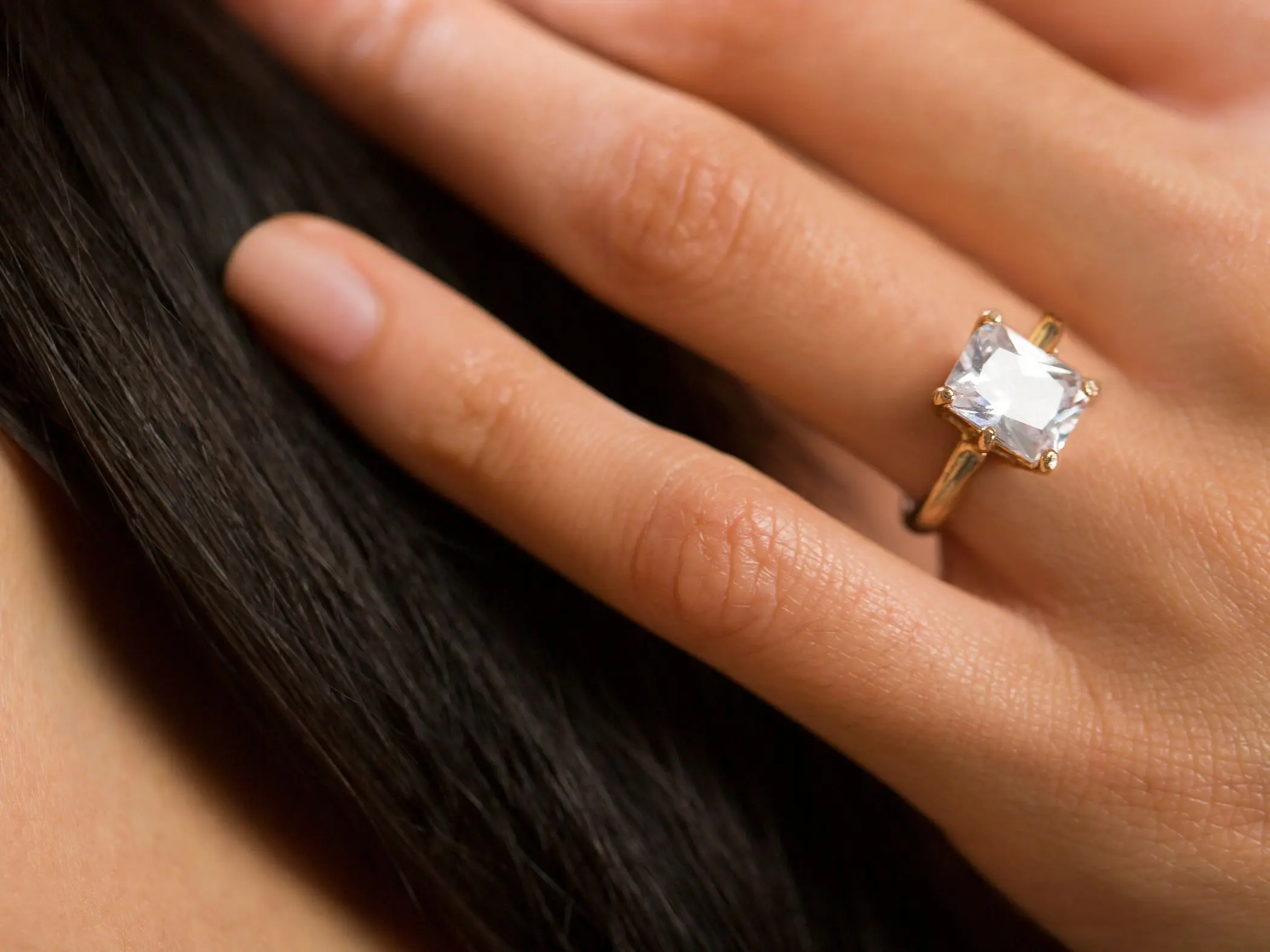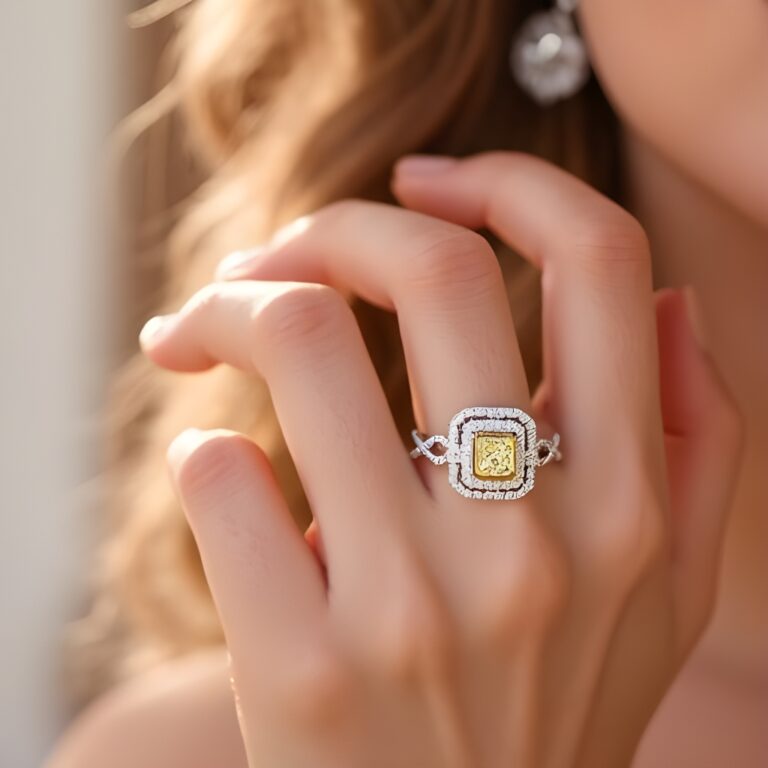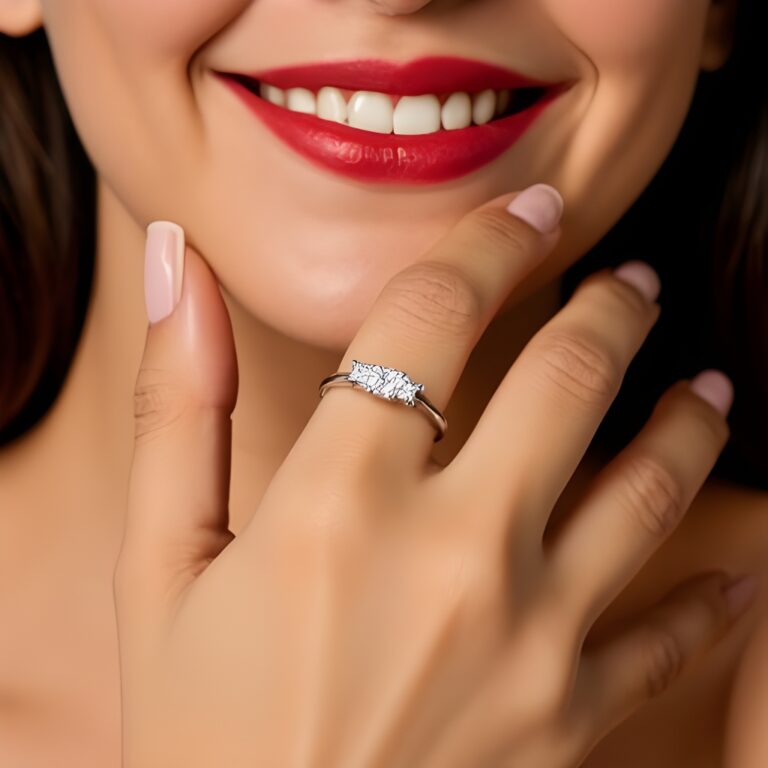Why Diamond Cut Matters
When evaluating a diamond, the cut is arguably the most crucial of the Four Cs (carat, cut, clarity, and color). The craftsman’s skill determines how light interacts with the diamond, influencing its brilliance, fire, and overall appearance.
A well-cut diamond will have the maximum light return, creating a dazzling display of brilliance and fire. The diamond may be absolutely flawless in every other way, but if it has a poor cut, it will look dead. The quality of the cut can significantly affect this value; obviously, the more beautifully cut the stone, the higher the price.
This is precisely why a diamond cut is a major consideration when purchasing a good-quality diamond. The well-informed buyer will always get value for money by selecting a diamond with a superior cut.
The Basics of Diamond Cut
The term 'diamond cut' encompasses the geometry, proportions, and all other factors that involve the diamond facets or surfaces. The shape of the diamond refers to the external contour shape of the diamond itself; it is not the angle of the diamond. For example, round, princess, pear. A well-designed diamond can let light enter and exit in rays of brilliance and fire.
How Diamond Cut Affects Brilliance
How a diamond is cut determines its ability to capture and return light. Precise angles and proportions ensure that light enters the diamond, reflects off its facets, and exits the stone as a dazzling display of brilliance. Poorly cut diamonds may allow light to escape through the pavilion or crown, resulting in a dull or lifeless appearance.
Cut Grades Explained
Cut grades are used to evaluate the quality of a diamond’s cut. Common cut grades include:
Excellent: The highest grade, indicating a diamond with exceptional proportions, angles, and symmetry.
Very Good: A high-quality cut with slight deviations from the ideal proportions.
Good: A decent cut with noticeable deviations from the ideal.
Fair: A cut with significant deviations affecting the diamond’s brilliance and fire.
Poor: An inferior cut with severe deviations, resulting in a dull and lifeless diamond.
Popular Diamond Cuts Explained
Round Brilliant Cut
The round brilliant cut is believed to be the most popular diamond cut because it produces the most brilliance and symmetry in the stone. It contains 58 facets, which reflect light in a manner that gives the appearance of burning fire and scintillation.
Princess Cut
The princess cut is one of the most popular fancy cuts. It resembles a square diamond with pointed corners. It offers a highly modern appearance and brilliance. It often serves as a trendy alternative to the more traditional round brilliant cut and quite regularly appears as a best-seller among engagement rings.
Cushion Cut
The cushion cut is a square, or more often rectangular, cut with rounded corners, giving it a classical, vintage appearance. It has rounded corners and a large, open table that can show the diamond's brilliance and fire.
Emerald Cut
The emerald cut is a rectangular cut with step-like facets. It is known for its elegant and sophisticated appearance and is often associated with vintage-inspired jewelry.
Oval, Marquise, and Pear Cuts
These are forms with different shapes and fashions. An oval cut shows its maximum grace and also portrays the wearer's finger as lengthy. The marquise cut is done with pointed ends, and this cut is normally associated with a more vintage or antique look. The pear cut is a mixture of a round and marquise shape, normally forming a unique and striking diamond.
Choosing the Perfect Diamond Cut
When evaluating a diamond, the cut is arguably the most crucial of the Four Cs (carat, cut, clarity, and color). The craftsman’s skill determines how light interacts with the diamond, influencing its brilliance, fire, and overall appearance.
A well-cut diamond will have the maximum light return, creating a dazzling display of brilliance and fire. The diamond may be absolutely flawless in every other way, but if it has a poor cut, it will look dead. The quality of the cut can significantly affect this value; obviously, the more beautifully cut the stone, the higher the price.
This is precisely why a diamond cut is a major consideration when purchasing a good-quality diamond. The well-informed buyer will always get value for money by selecting a diamond with a superior cut.
Consider Your Style
Style and preference are two notable factors to consider while choosing a diamond cut. For instance, if one loves the traditional look, the round brilliant cut will probably be the one. The princess or cushion cuts would work well for those wanting something more contemporary. If you are looking for something different, consider any elongated shapes, such as oval, marquise, or pear.
Matching the Cut with the Setting
Factors that affect the decision on the cut may also include the setting. Admittedly, some cuts look better with specific settings. A good example is the round brilliant cut. It is one of the few cuts that go with many settings, while the emerald cut is best seen in the prong setting.
Balancing Cut with Other Cs
To obtain the very best diamond in all aspects, there is a trade-off between cut and the other Cs: carat, color, and clarity. A good cut can mask a certain degree of color or clarity defects, but a poor cut will make a heavier carat weight or higher clarity grade less brilliant.
Budget Considerations
The cut of a diamond can have a significant effect on its price. Generally, the finer the cut grade of a diamond, the more expensive it is. On the contrary, outstanding-cut diamonds can be had at various price levels. You can find an attractive yet affordable diamond with proper budget planning and priority in choosing the cut that best fits your needs and preferences.
Why Certification Matters
Understanding Diamond Certification
Diamond certification is a process where a reputable gemological laboratory assesses a diamond’s quality based on the Four Cs: carat, cut, clarity, and color. This certification provides a reliable and impartial evaluation of the diamond’s characteristics, ensuring buyers can make informed decisions.

Top Certification Bodies
The most respected diamond certification bodies include:
- GIA (Gemological Institute of America): Widely recognized as the industry standard, GIA certifications are highly sought after.
- AGS (American Gem Society): Another reputable organization known for its rigorous grading standards.
What to Look for in a Certificate
When examining a diamond certificate, pay attention to the following details:
- Cut grade: Ensure the cut grade is as high as possible (e.g., Excellent, Very Good).
- Proportions: Check that the diamond’s proportions are within the ideal range.
- Symmetry: Verify that the diamond’s facets are symmetrical, contributing to its brilliance.
- Clarity grade: Assess the clarity grade to understand the diamond’s internal flaws.
- Color grade: Evaluate the color grade to determine the diamond’s purity.
The certificate can certainly guarantee one’s peace of mind and raise the selling price of the diamond. A laboratory certificate must also be obtained any time a diamond is purchased.
Find Your Perfect Diamond Cut Today
What Are Diamond Cut Grades?
Diamond cut grades are crucial in evaluating a diamond’s quality. They assess how well a diamond has been cut, considering its proportions, symmetry, and polish. These factors directly influence how light interacts with the diamond, determining its brilliance and sparkle.
The Scale of Cut Grades
Diamond cut grades are typically categorized into five primary levels:
- Excellent: The highest grade, representing a diamond with optimal proportions and symmetry. This results in the maximum light being reflected, creating the most brilliance and fire.
- Very Good: A diamond with slightly less precision than Excellent. While still offering great brilliance and light reflection, it may exhibit minor deviations from the ideal proportions.
- Good: A diamond that reflects most light but with noticeable differences in brilliance compared to higher grades. It may have some imperfections in its proportions or symmetry.
- Fair: A diamond that reflects minimal light due to less precise proportions. This results in reduced sparkle and a less desirable appearance.
- Poor: The lowest grade, with proportions significantly impacting the diamond’s ability to reflect light. This results in a dull and lifeless appearance.
How Cut Grades Impact Value
The cut grade of a diamond directly affects its value. Higher-cut grades like Excellent and Very Good are more desirable and command higher prices. These diamonds offer superior brilliance and fire, making them more attractive to buyers. Lower grades like Fair and Poor are less expensive but lack brilliance, which can reduce their overall appeal.

Key Characteristics of a Well-Cut Diamond
The cut of a diamond is one of the most critical factors in determining its beauty and value. A well-cut diamond maximizes its brilliance and fire, making it sparkle and shine. Understanding the key characteristics of a well-cut diamond can help you select the perfect stone for your needs.
Proportions
The proportions of a diamond are the balance between its dimensions, including its depth, width, and length. Optimal proportions ensure light enters the diamond, reflects off its facets, and exits the stone with maximum brilliance.
Symmetry
Symmetry refers to the even alignment of a diamond's facets. A diamond with good symmetry will interact with light consistently, enhancing its sparkle and brilliance.
Polish
The polish is the smoothness of the diamond's surface. A well-polished diamond will allow light to enter and exit the stone without scattering, resulting in a more precise and focused display of brilliance.
Table Size
The table size in a diamond refers to the size of the top facet. It is relevant for the alignment and installation of the diamond. If the table is very strong, it may permit an escape of excess light, dulling the appeal of the diamond. If it's too thin, on the other hand, then the amount of light that can penetrate the diamond will be restricted.
Depth Percentage
For every diamond, there is also the depth ratio relative to the diameter, called the depth percentage. It governs the content of light occurring inside the diamond. A diamond with an adequately set depth ratio will maximize its brilliance and fire.
Key Characteristics of a Well-Cut Diamond
The cut of a diamond is one of the most critical factors in determining its beauty and value. A well-cut diamond maximizes its brilliance and fire, making it sparkle and shine. Understanding the key characteristics of a well-cut diamond can help you select the perfect stone for your needs.
Proportions
The proportions of a diamond are the balance between its dimensions, including its depth, width, and length. Optimal proportions ensure light enters the diamond, reflects off its facets, and exits the stone with maximum brilliance.
Symmetry
Symmetry refers to the even alignment of a diamond's facets. A diamond with good symmetry will interact with light consistently, enhancing its sparkle and brilliance.
Polish
The polish is the smoothness of the diamond's surface. A well-polished diamond will allow light to enter and exit the stone without scattering, resulting in a more precise and focused display of brilliance.
Table Size
The table size in a diamond refers to the size of the top facet. It is relevant for the alignment and installation of the diamond. If the table is very strong, it may permit an escape of excess light, dulling the appeal of the diamond. If it's too thin, on the other hand, then the amount of light that can penetrate the diamond will be restricted.
Depth Percentage
For every diamond, there is also the depth ratio relative to the diameter, called the depth percentage. It governs the content of light occurring inside the diamond. A diamond with an adequately set depth ratio will maximize its brilliance and fire.
The Influence of Diamond Cut on Price
Diamond cut is a significant factor in determining a diamond’s price. A well-cut diamond can significantly enhance its brilliance and value, while a poorly cut diamond can diminish its appeal. Understanding how diamond cut influences price can help you make informed decisions when purchasing a diamond.
Cut Quality and Value
The quality of a diamond's cut directly influences its value. A well-cut diamond with excellent proportions, symmetry, and polish will reflect light more effectively, creating a dazzling display of brilliance and fire. This superior optical performance makes such diamonds more desirable and more expensive.
Premium for Excellent Cuts
Buyers look for diamonds with a Great cut grade, especially tip-top cut grades like the Exclusive or the Very Good offshore. This increased demand leads to rising price levels for these diamonds. A premium is usually charged on such cuts due to their remarkable brilliance and fire.
Cost Differences Across Cut Grades
The difference in price between diamonds with different cut grades can be significant. Even if two diamonds have similar carat weights, colors, and clarity grades, a diamond with a higher cut grade will cost more. The added value and desirability of a well-cut diamond justify the premium price.
Balancing Cut with Budget
An Excellent cut ensures brilliance and all the value one would look for in a diamond despite being out of reach for most people. A Very Good cut would reduce the price while retaining a fair amount of sparkle and brilliance. However, it is possible to economize when purchasing diamonds. After all, it is only a pragmatic approach against the "customary approach."
Key Characteristics of a Well-Cut Diamond
The cut of a diamond is one of the most critical factors in determining its beauty and value. A well-cut diamond maximizes its brilliance and fire, making it sparkle and shine. Understanding the key characteristics of a well-cut diamond can help you select the perfect stone for your needs.
Proportions
Proportions deal with the diamond's depth, width, and angles. These factors affect the diamond's light reflection. The proportions, which are considered perfect, result in the intense sparkle of the stone as more light penetrates in, bounces off the different facets of the diamond, and shimmers out.
Symmetry
Symmetry is the even alignment of a diamond's facets. A diamond with good symmetry will interact with light consistently, enhancing its sparkle and brilliance. Misaligned facets can cause light to scatter, reducing the diamond's overall appearance.
Polish
Polish is the term for the smoothness of a diamond's surface. If the diamond is well polished, light will enter or leave the stone without dispersing, enhancing the diamond's fire. Badly cut diamonds may seem cloudy or lifeless.
Facet Alignment
Facet alignment is the precision with which the diamond's facets are cut and positioned. Proper alignment ensures light reflects off the facets correctly, maximizing the diamond's brilliance. Misaligned facets can disrupt the light path, reducing the diamond's sparkle.
Cut Grade
The cut grade encompasses all these parameters into a single measure of how a diamond performs in relation to light. A high cut grade, such as Excellent or Very Good, would be a diamond with the best proportions, symmetry, and polish, making it one with the most beauty and brilliance.
4 Things to Know About Diamond Size
Carat Weight Doesn’t Equal Size
While carats measure a diamond’s weight, they don’t directly correlate with its size. Two diamonds with the same carat weight can look significantly different in size due to their shape, cut, and setting.

Shape Affects Perceived Size
The shape of a diamond can impact its perceived size. Elongated shapes like ovals and marquise can appear larger than round diamonds of the same carat weight because they cover more surface area.
Cut Quality Impacts Size Perception
A well-cut diamond reflects light more efficiently, making it appear larger and more brilliant. Even with the same carat weight, a poorly cut diamond may look smaller and less impressive.
Setting Can Enhance Size
The setting can also influence how a diamond appears in terms of size. Settings like halos or bezels can make a diamond look larger by framing it and creating the illusion of a bigger stone.
Ready to find the perfect diamond for your special occasion? Visit DiamondNet today to explore our stunning diamond collection and discover the beauty of a well-cut stone. Our expert team is here to guide you through the selection process and help you find the diamond of your dreams.













